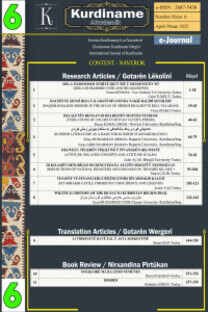KURDISH LANGUAGE, ITS FAMILY AND DIALECTS
Kurdish Language, Northern Kurdish, Central Kurdish, Southern Kurdish, Gorani, Zazaki, Hawrami.
KURDISH LANGUAGE, ITS FAMILY AND DIALECTS
Kurdish Language, Northern Kurdish, Central Kurdish, Southern Kurdish, Gorani, Zazaki, Hawrami.,
___
- Anderson, B. (1999). Imagined Communities: Reflections on the Origin and Spread of Nationalism. (R. edition, Ed.) London ; New York : Verso: British Library cataloguing in publication data . Aslan, S. (2009). Incoherent State: The Controversy over Kurdish Naming in Turkey. European Journal of Turkish Studies, 10, 1-20.
- Baldi, P., & Cuzzolin, P. (2015). Indo-European Languages. International Encyclopedia of the Social & Behavioral Sciences, 820-827.
- Jawari, F. (1998). Hawar Magazine, 1, 1-23 (1932-1933). Stockholm: Nûdem.
- Chambers, J. K., & Trudgill, P. (2004). Dialectology. (2. Edition, Ed.) Cambridge: Cambridge University Press.
- Ethnologue. (2019, August 1). Ethnologue. Retrieved from https://www.ethnologue.com/
- Google Map (2019). Google map. Retrieved from https://www.google.com/maps
- Haig, G., & Öpengin, E. (2015). Gender in Kurdish Structural and socio-cultural dimensions. In M. Hellinger, & H. Motschenbacher, Gender Across Languages (pp. 247-276). John Benjamins.
- Hama-Khurshid, F. (2008) Kurdish language and its dialects, a geographic analysis [Zmani Kurdi u diyalektakani, shikrdnawayaki jugrafyayi]. Slemani, Sardam publishing.
- Hassanpour, A. (1993). Kurdish Studies: Orientalist, Positivist, and Critical Approaches: Review Essay Kurdish Ethnonationalism by Nader Entessar. The Middle east Journal, 47(1), 119-122.
- Ismail, Z. B. (1977) Kurdish language history [tarikh al-alughat al-kurdiya]. Baghdad, al-Hawadth.
- Khalid, H. S. (2013). The language and politics od Iraqi Kurdistan. Lambert academic Publishing. ISBN: 978-3659800405
- Khalid, H. S. (2015). Kurdish dialect continuum, as a standardization solution. International Journal of Kurdish Studies, 1(1), 27-39.
- Bedlîsî, Ş. (2014). Şerefname -Dîroka Kurdistanê [Sharafnama – Kurdistan History]. Translator: Ziya Avcı. Istanbul: Azad.
- Öpengin, E. (2011). Rewşa Kurdî ya sosyolenguîstîk li Tirkiyeyê [Kurdish sociolinguistic situation in Turkey]. Istanbul: Avesta.
- Saussure, F. d. (1998). Course in General Linguistics. (R. Harris, Trans.) Open Court.
- Sheyholislami, J. (2015). Language varities of the Kurds. The Kurds: History–Religion–Language–Politics , 30-52.
- Khani, A. (2017). Mem û Zîn. Edition: Şamîl Esgerov; Mehmet Kaplan; Huseyn Şemrexî. Istanbul: Nûbihar.
- ISSN: 2687-5438
- Yayın Aralığı: Yılda 2 Sayı
- Başlangıç: 2019
- Yayıncı: Osman ASLANOĞLU
PATRONAJ, EĞITIM, TOPLUMSAL ROL VE BAKIŞ VE SANATI İCRA ETME YÖNÜNDEN KADININ DENGBÊJLİĞİ
NIRXANDINA ÇANDA QUBEDEYÊN DIYARBEKIRÊ LI GOR QALIBA EŞQIYAYÊN CIVAKÎ YA ERIC HOBSBAWM
KURDISH LANGUAGE, ITS FAMILY AND DIALECTS
Hewa S. KHALİD, Çevirmen: Hewa S. KHALİD
میتۆدە نوێیەکانی فێرکردنی زمانی دووەم و کاریگەرییان لەسەر زمانی کوردی
ERGATÎVÎ DI KURDIYA KURMANCÎ DE Û REWŞÊN AWARTE YÊN ERGATÎVIYA KURMANCÎ
DAHÛRANDINA ÇîROKA “EHMEDÊ ZEYDAN” LI GOR RÊBAZA MORFOLOJÎK A VLADIMIR PROPP
DI DÎWANA PERTO BEGÊ HEKKARÎ DE POR
MS GULPĀYGĀNĪ 1246: A CONTINUATION TO THE ARDALĀN CHAPTER OF SHARAF-NĀMA
